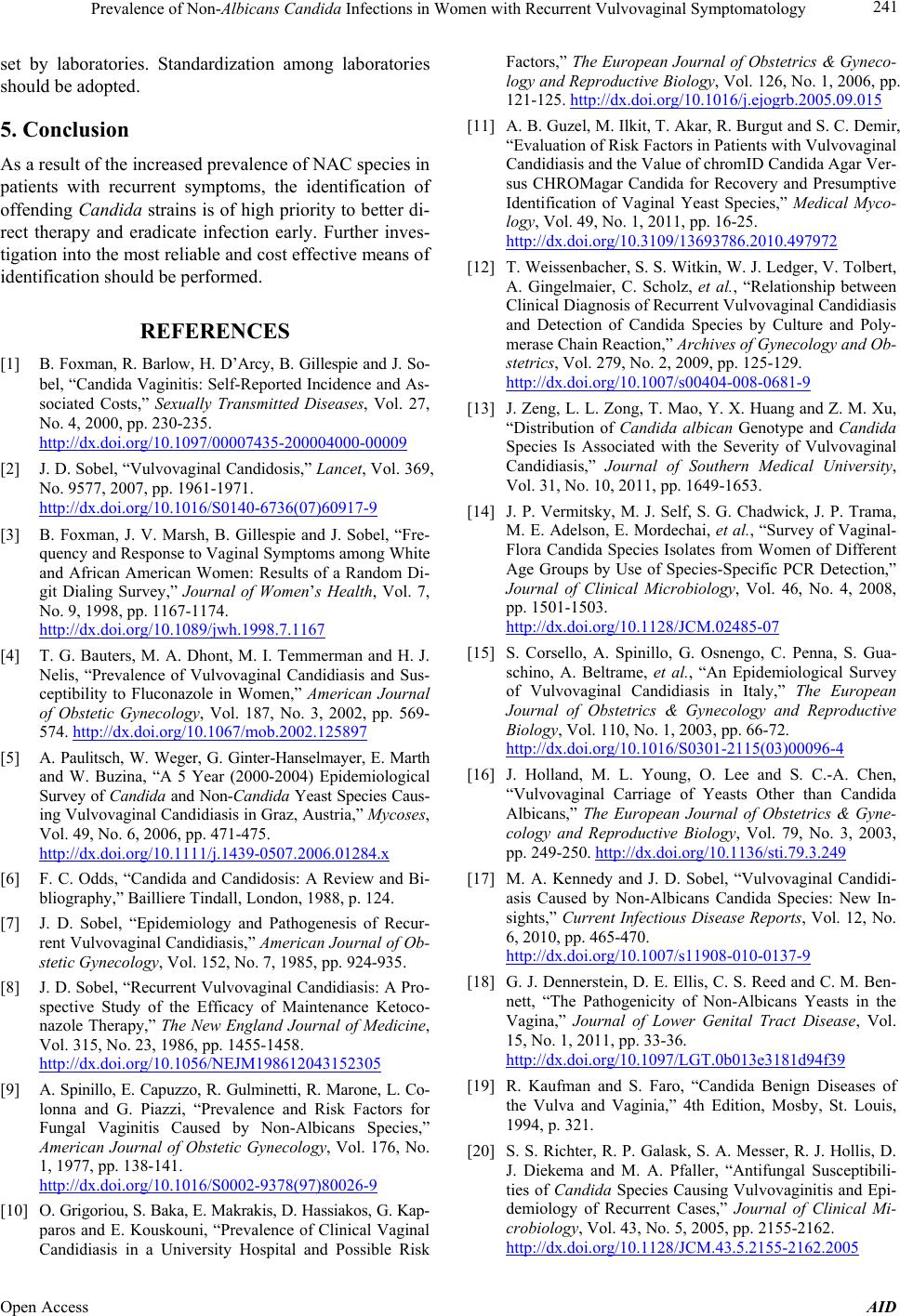
Prevalence of Non-Albicans Candida Infections in Women with Recurrent Vulvovaginal Symptomatology 241
set by laboratories. Standardization among laboratories
should be adopted.
5. Conclusion
As a result of the increased prevalence of NAC species in
patients with recurrent symptoms, the identification of
offending Candida strains is of high priority to better di-
rect therapy and eradicate infection early. Further inves-
tigation into the most reliable and co st effective means of
identification shou ld be performed.
REFERENCES
[1] B. Foxman, R. Barlow, H. D’Arcy, B. Gillespie and J. So-
bel, “Candida Vaginitis: Self-Reported Incidence and As-
sociated Costs,” Sexually Transmitted Diseases, Vol. 27,
No. 4, 2000, pp. 230-235.
http://dx.doi.org/10.1097/00007435-200004000-00009
[2] J. D. Sobel, “Vulvovaginal Candidosis,” Lancet, Vol. 369,
No. 9577, 2007, pp. 1961-1971.
http://dx.doi.org/10.1016/S0140-6736(07)60917-9
[3] B. Foxman, J. V. Marsh, B. Gillespie and J. Sobel, “Fre-
quency and Response to Vaginal Symptoms among White
and African American Women: Results of a Random Di-
git Dialing Survey,” Journal of Women’s Health, Vol. 7,
No. 9, 1998, pp. 1167-1174.
http://dx.doi.org/10.1089/jwh.1998.7.1167
[4] T. G. Bauters, M. A. Dhont, M. I. Temmerman and H. J.
Nelis, “Prevalence of Vulvovaginal Candidiasis and Sus-
ceptibility to Fluconazole in Women,” American Journal
of Obstetic Gynecology, Vol. 187, No. 3, 2002, pp. 569-
574. http://dx.doi.org/10.1067/mob.2002.125897
[5] A. Paulitsch, W. Weger, G. Ginter-Hanselmayer, E. Marth
and W. Buzina, “A 5 Year (2000-2004) Epidemiological
Survey of Candi da and Non-Candida Yeast Species Caus-
ing Vulvovaginal Candidiasis in Graz, Austria,” Mycoses,
Vol. 49, No. 6, 2006, pp. 471-475.
http://dx.doi.org/10.1111/j.1439-0507.2006.01284.x
[6] F. C. Odds, “Candida and Candidosis: A Review and Bi-
bliography,” Bailliere Tindall, London, 1988, p. 124.
[7] J. D. Sobel, “Epidemiology and Pathogenesis of Recur-
rent Vulvovaginal Candidiasis,” American Journal of Ob-
stetic Gynecology, Vol. 152, No. 7, 1985, pp. 924-935.
[8] J. D. Sobel, “Recurrent Vulvovaginal Candidiasis: A Pro-
spective Study of the Efficacy of Maintenance Ketoco-
nazole Therapy,” The New England Journal of Medicine,
Vol. 315, No. 23, 1986, pp. 1455-1458.
http://dx.doi.org/10.1056/NEJM198612043152305
[9] A. Spinillo, E. Capuzzo, R. Gulminetti, R. Marone, L. Co-
lonna and G. Piazzi, “Prevalence and Risk Factors for
Fungal Vaginitis Caused by Non-Albicans Species,”
American Journal of Obstetic Gynecology, Vol. 176, No.
1, 1977, pp. 138-141.
http://dx.doi.org/10.1016/S0002-9378(97)80026-9
[10] O. Grigoriou, S. Baka, E. Makrakis, D. Hassiako s, G. Kap-
paros and E. Kouskouni, “Prevalence of Clinical Vaginal
Candidiasis in a University Hospital and Possible Risk
Factors,” The European Journal of Obstetrics & Gyneco-
logy and Reproductive Biology, Vol. 126, No. 1, 2006, pp.
121-125. http://dx.doi.org/10.1016/j.ejogrb.2005.09.015
[11] A. B. Guzel, M. Ilkit, T. Akar, R. Burgut and S. C. Demir,
“Evaluation of Risk Factors in Patients with Vulvovaginal
Candidiasis and the Value of chromID Candida Agar Ver-
sus CHROMagar Candida for Recovery and Presumptive
Identification of Vaginal Yeast Species,” Medical Myco-
logy, Vol. 49, No. 1, 2011, pp. 16-25.
http://dx.doi.org/10.3109/13693786.2010.497972
[12] T. Weissenbacher, S. S. Witkin, W. J. Ledger, V. Tolbert,
A. Gingelmaier, C. Scholz, et al., “Relationship between
Clinical Diagnosis of Recurrent Vulvovaginal Candidiasis
and Detection of Candida Species by Culture and Poly-
merase Chain Reaction,” Archives of Gynecology and Ob-
stetrics, Vol. 279, No. 2, 2009, pp. 125-129.
http://dx.doi.org/10.1007/s00404-008-0681-9
[13] J. Zeng, L. L. Zong, T. Mao, Y. X. Huang and Z. M. Xu,
“Distribution of Candida albican Genotype and Candida
Species Is Associated with the Severity of Vulvovaginal
Candidiasis,” Journal of Southern Medical University,
Vol. 31, No. 10, 2011, pp. 1649-1653.
[14] J. P. Vermitsky, M. J. Self, S. G. Chadwick, J. P. Trama,
M. E. Adelson, E. Mordechai, et al., “Survey of Vaginal-
Flora Candida Species Isolates from Women of Different
Age Groups by Use of Species-Specific PCR Detection,”
Journal of Clinical Microbiology, Vol. 46, No. 4, 2008,
pp. 1501-1503.
http://dx.doi.org/10.1128/JCM.02485-07
[15] S. Corsello, A. Spinillo, G. Osnengo, C. Penna, S. Gua-
schino, A. Beltrame, et al., “An Epidemiological Survey
of Vulvovaginal Candidiasis in Italy,” The European
Journal of Obstetrics & Gynecology and Reproductive
Biology, Vol. 110, No. 1, 2003, pp. 66-72.
http://dx.doi.org/10.1016/S0301-2115(03)00096-4
[16] J. Holland, M. L. Young, O. Lee and S. C.-A. Chen,
“Vulvovaginal Carriage of Yeasts Other than Candida
Albicans,” The European Journal of Obstetrics & Gyne-
cology and Reproductive Biology, Vol. 79, No. 3, 2003,
pp. 249-250. http://dx.doi.org/10.1136/sti.79.3.249
[17] M. A. Kennedy and J. D. Sobel, “Vulvovaginal Candidi-
asis Caused by Non-Albicans Candida Species: New In-
sights,” Current Infectious Disease Reports, Vol. 12, No.
6, 2010, pp. 465-470.
http://dx.doi.org/10.1007/s11908-010-0137-9
[18] G. J. Dennerstein, D. E. Ellis, C. S. Reed and C. M. Ben-
nett, “The Pathogenicity of Non-Albicans Yeasts in the
Vagina,” Journal of Lower Genital Tract Disease, Vol.
15, No. 1, 2011, pp. 33-36.
http://dx.doi.org/10.1097/LGT.0b013e3181d94f39
[19] R. Kaufman and S. Faro, “Candida Benign Diseases of
the Vulva and Vaginia,” 4th Edition, Mosby, St. Louis,
1994, p. 321.
[20] S. S. Richter, R. P. Galask, S. A. Messer, R. J. Hollis, D.
J. Diekema and M. A. Pfaller, “Antifungal Susceptibili-
ties of Candida Species Causing Vulvovaginitis and Epi-
demiology of Recurrent Cases,” Journal of Clinical Mi-
crobiology, Vol. 43, No. 5, 2005, pp. 2155-2162.
http://dx.doi.org/10.1128/JCM.43.5.2155-2162.2005
Open Access AID